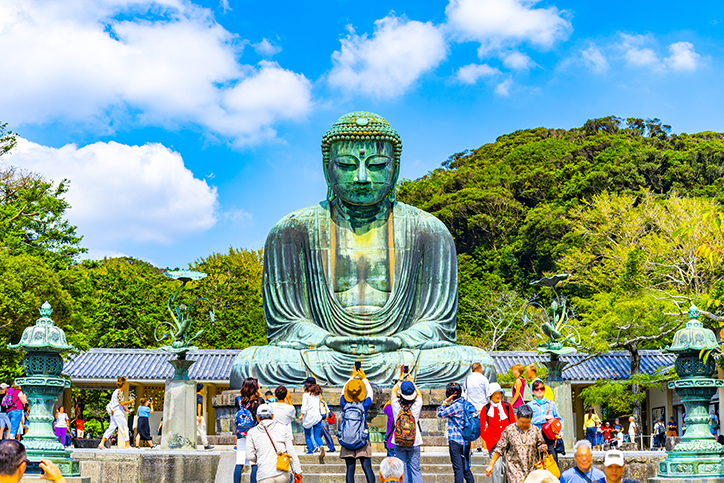Buddhism in Japan Today
The majority of the people in Japan probably would not consider themselves to be Buddhist or belonging to any particular religion at all. However, many cultural traditions in Japan are derived from Buddhism.

Japanese Cultural Traditions Originating from Buddhism
First off, almost 90% of funerals in Japan are performed by Buddhist monks. So, the religion of Japan has sometimes been described as “funeral Buddhism”. For some people, it could be the only time they even visit a Buddhist temple other than as a place for sightseeing.
Second, is during the New Year’s holidays. On New Year’s Eve, people gather to temples (or shrines) to thank the gods for the past year and to pray for good fortune during the coming year. Buddhist monks strike a large bell on the temple grounds 108 times, the number of the sins of humanity according to Buddhism. Striking the bell is thought to cleanse and purify the world. At some temples, the people who gather there are permitted to strike the bell instead of the monks.
Third, a tradition called “Setsubun” or seasonal division with Buddhism at its roots. It is held in the beginning of February to drive the “demons” or evil spirits out of homes or temples. As a cultural ritual, usually a male figure wears a demon mask. Children chant “out with the demons” while throwing roasted soybeans at the demon and driving it out of the building. Then they chant “good luck come in” while throwing beans into the house. Afterwards, eating the same number of shelled soybeans as your own age is said to bless you with good health for the whole year.
Fourth, a tradition held in the middle of summer called “Obon” to honour the ancestors. Though the timing of this “obon” festival is different according to different regions in Japan, it is thought that the spirits of the ancestors come back to visit their living family once a year at this time. People gather at their family homes to clean gravestones and household altars, offer flowers and food to the ancestors, and have prayers chanted by a Buddhist monk at the temple for their ancestors. These traditions are also starting to disappear with the older generation, but “obon” is still a time when many people go and visit their family.
Shintoism vs Buddhism
The Japanese tend to consider themselves non-religious, but they do visit both Shinto shrines and Buddhist temples indiscriminately. Shintoism is an indigenous religion of Japan, believing that all things, even the inanimate ones, have a spirit. The spirits are called “kami” or gods and are worshipped.
Buddhism on the other hand originated in India and was brought to Japan via China. Buddhists venerate a human being who has achieved enlightenment, Buddha, and not a god.
At a Shinto shrine, there will be a torii gate at the entrance and the shrine is usually a bright red colour. There will also be statues of foxes, dogs, or other animals guarding the shrine. And there is a water basin where people purify their hands and mouth before entering. When you pray at the altar of a shrine, there will sometimes be a decorated rope with bells hanging down from the ceiling, but not always. If there is, give it a shake to ring the bells and rouse the gods. Then throw in a small offering into the money box. Clap your hands twice, and pray with your hands clapped together. Then bow again before leaving.
At a Buddhist temple, you will note that the exterior of the temple is usually just natural wood without any extravagant decorations. However, inside the main temple building where the statue of Buddha or a Bodhisattva is enshrined, it will be lavishly decorated in a gold colour. And in addition to the water basin like at a shrine, sometimes there is a large incense burner out in front where you waft the smoke toward your body to purify yourself. At the altar, you throw in your coin(s) as an offering into the box, quietly put your hands together and pray. Then bow once before leaving.
These two religions, Shintoism, and Buddhism are non-exclusive and now exist in harmony. Sometimes you will find both a shrine and a temple on the same grounds. Maybe this tolerance of other religions is the reason why Japanese people find no problem whatsoever with enthusiastically participating in events of both and even incorporate events from other religions or countries into their lives easily.










